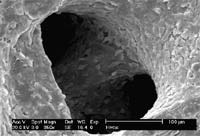Articles and reports from the Life Sciences and chemistry area deal with applied and basic research into modern biology, chemistry and human medicine.
Valuable information can be found on a range of life sciences fields including bacteriology, biochemistry, bionics, bioinformatics, biophysics, biotechnology, genetics, geobotany, human biology, marine biology, microbiology, molecular biology, cellular biology, zoology, bioinorganic chemistry, microchemistry and environmental chemistry.

Shewanella bacterium can remove toxic metals from environment
Rockville, MD. – Scientists at The Institute for Genomic Research (TIGR) and collaborators elsewhere have deciphered the genome of a metal ion-reducing bacterium, Shewanella oneidensis, that has great potential as a bioremediation agent to remove toxic metals from the environment.
The genome sequence sheds new light on the biochemical pathways by which the bacterium “reduces” and precipitates chromium, uranium and

But new study sheds light on what makes leaves turn red
Groundhog behavior is supposedly a harbinger of spring.
Wooly Bear Caterpillars are a possible portent of the severity of winter.
But who knows when the Vermont forests will blaze with autumnal gold, orange and scarlet?
Not the weather forecasters, not the almanacs, not some octogenarian recluse Vermonter. Leave that to the scientists.
Here in Vermont where one out of four of the forests’

New gene therapy procedures, DNA-based sensors, and other medical applications may be possible using a new method to initiate and control chemical reactions on DNA strands, developed by a team of chemists at the U.S. Department of Energy’s Argonne National Laboratory. The new technology uses specially designed nanometer-sized semiconductors–less than a billionth of an inch in size.
The technology is based on the group’s discovery of “conductive linkers”–small organic molecules th

New research into how biodiversity is generated and maintained in the seas surrounding hostile Polar Regions is reported in this month`s Proceedings of the Royal Society (Biological Sciences).
British Antarctic Survey biologist David Barnes studied `battles` between rock-dwelling marine organisms in shallow seas from the Poles to tropics to come up with a `league table` and a `polar pecking order` that lead to a greater understanding of extreme environments and how marine organisms may reac

Two scientists at The Scripps Research Institute (TSRI) led a collaborative effort involving 18 researchers at half a dozen laboratories in the United States and Great Britain to determine the “proteome” of the most deadly form of the malaria pathogen – Plasmodium falciparum .
This study, in the current issue of the journal Nature, accompanies an article detailing the completion of a major six-year $17.9-million genome-sequencing effort involving 185 researchers from the United Kingd

Researchers use flowing fluids to create mechanical stress needed for bone formation
A new study by Rice University researchers indicates that bioengineers growing bone in the laboratory may be able to create the mechanical stimulation needed to grow bone outside the body.
One of the greatest challenges tissue engineers face in growing bone in the laboratory is recreating the conditions that occur inside the body. The recipe for growing healthy bones includes not only a prec